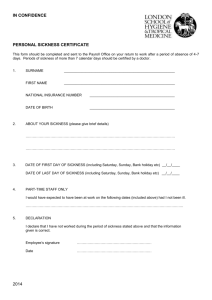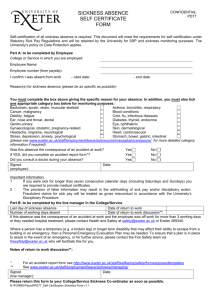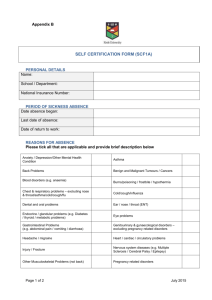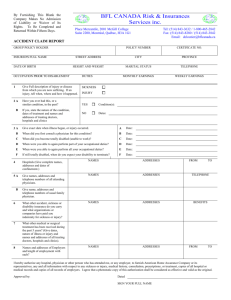Sickness Absence Management Policy
advertisement
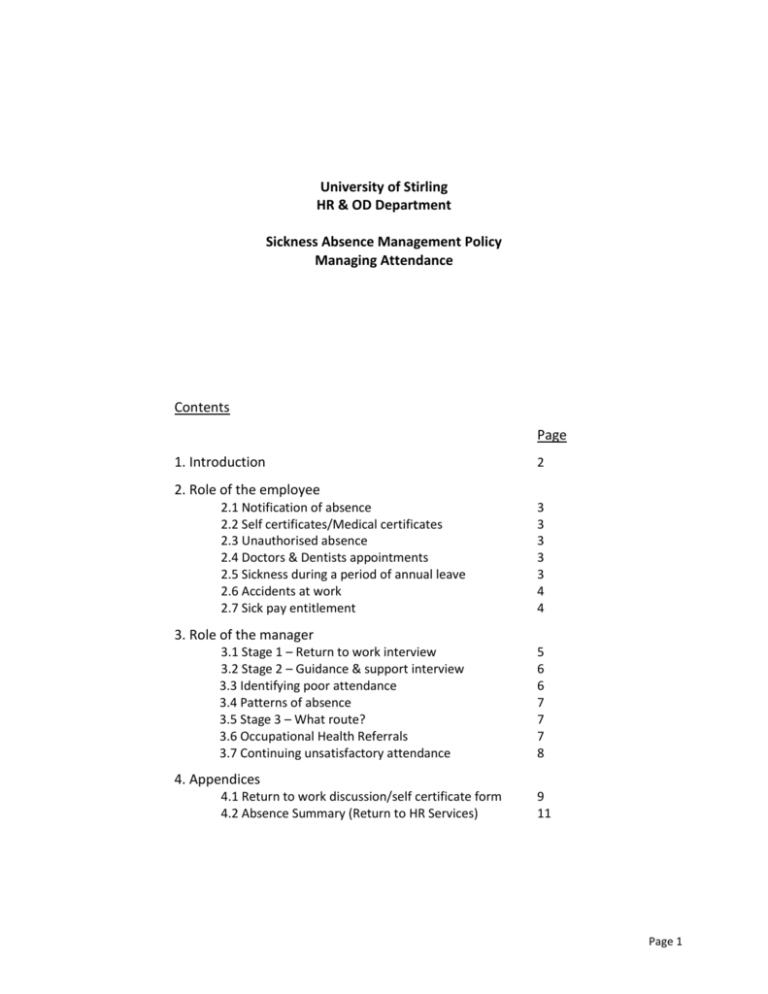
University of Stirling HR & OD Department Sickness Absence Management Policy Managing Attendance Contents Page 1. Introduction 2 2. Role of the employee 2.1 Notification of absence 2.2 Self certificates/Medical certificates 2.3 Unauthorised absence 2.4 Doctors & Dentists appointments 2.5 Sickness during a period of annual leave 2.6 Accidents at work 2.7 Sick pay entitlement 3 3 3 3 3 4 4 3. Role of the manager 3.1 Stage 1 – Return to work interview 3.2 Stage 2 – Guidance & support interview 3.3 Identifying poor attendance 3.4 Patterns of absence 3.5 Stage 3 – What route? 3.6 Occupational Health Referrals 3.7 Continuing unsatisfactory attendance 5 6 6 7 7 7 8 4. Appendices 4.1 Return to work discussion/self certificate form 4.2 Absence Summary (Return to HR Services) 9 11 Page 1 POLICY ON THE MANAGEMENT OF SICKNESS ABSENCE 1. INTRODUCTION The University of Stirling recognises the considerable commitment which many staff, in all categories of employment, demonstrate on a day-to-day basis. But those of us working in the University community, whether as support staff, academics or in other roles, are not immune to sickness. Like other large organisations, therefore, we need a positive approach to sickness management. This approach must above all be supportive, ensuring that staff are treated in a manner which is fair and appropriate, whilst recognising the need for the University to continue to function effectively. One of our key aims is to encourage all staff to behave with diligence in discharging the duties associated with their role in the University. For some, that will require routine attendance at specified hours. For others, it is entirely appropriate that their work be undertaken at home, in laboratories or libraries away from Stirling, through extended periods of fieldwork, or through participation in conferences and the many other activities that constitute good academic practice. We therefore need robust policies on sickness management that recognise the differing tasks and activity patterns of various staff. Unfortunately, absence of staff due to sickness has a direct impact upon the University including replacement costs; disruption to work, increased workload for colleagues which can lead to increased tensions, anxieties, stress and low morale. Higher than normal levels of absence may also be indicative of problems within the work environment. As an employer committed to the wellbeing of its staff, the University is concerned to take all reasonable steps to ensure that staff health issues, and any associated factors in the work environment, are identified at an early stage and that appropriate action is taken to address these. For those reasons the University is introducing an updated specific policy and set of procedures on the management of absence due to sickness which has been agreed by all Campus Trade Unions, UCU, Unison and Amicus There are a number of key players whose roles are key to this policy; these are individual employees, those assigned line management responsibilities, HR & OD Department and the Occupational Health Service. This policy document explores the complementary role of each of these players. Above all, the University recognises that it has a responsibility to ensure that we have a healthy community, and that, for those who have been afflicted by illness, distinct steps need to be taken to manage sickness absence, and the eventual smooth return to work of such individuals. Appropriate training will be provided for Managers to equip them with the skills and knowledge to implement the policy in a fair, sensitive and effective manner. Due to the complex management structures and the use of different designations within the University, the term Manager can refer to an individuals Line Manager, School Manager, Head of School or their delegated nominee in such matters. The document forms part of the University’s policies and procedures and as such supersedes any previous editions issued before June 2006 or contained with any of the staff handbooks. Page 2 2. THE ROLE OF THE EMPLOYEE 2.1 Notification of Absence It is a condition of employment that staff who are unable to work due to illness, injury or some unforeseen circumstance should notify their Manager or agreed alternative (e.g. School Office) on the first day of absence and, where possible, within one hour of their normal starting time for work. In some instances, cover will need to be arranged to cover an absence e.g. in the case of staff who work shifts, so notice of absences will be required at the earliest opportunity. It is also important for employees to keep in regular contact with their Managers thereafter if the absence is for more than one day. Sufficient details should be given on the telephone regarding the nature of the illness or injury to give some indication as to when a return to work is expected. While it is expected that a member of staff should make the phone call themselves, it is accepted that, due to the nature of the illness, this may not always be possible. In such cases a call from a relative or friend will be acceptable. 2.2 Self Certificates/Medical Certificates If the period of absence is between 0.5 - 7 calendar days, you should complete the combined return to work/self-certificate form on your return to work. (See Appendix 1). The School Manager should have a supply of these forms. This should then be forwarded to your Manager who will have a return to work discussion with you. The form then goes direct to HR & OD Department. If the absence is for more than 7 calendar days (inclusive of Saturdays and Sundays), then in addition to the self-certification form, you must provide a medical certificate signed by a registered medical practitioner. This certificate should be forwarded as soon as possible to your Manager who will subsequently forward on to HR & OD Department. All certificates will be treated as confidential. It is important that the full period of absence is covered by medical certificates. Should you wish to return to work prior to the expiry of the period covered in the medical certificate, a note from your doctor is required stating that they consider you fit to do so. Failure to submit medical certificates on time to cover a period of absence may result in disciplinary action being invoked (see 2.3 below). 2.3 Unauthorised Absence You should be aware that failure to report sickness absence (or any other absence without prior permission from your manager) within a reasonable period of time, usually, on first day of absence, will normally be regarded as unauthorised absence. This may be considered as a disciplinary matter and dealt with under the appropriate disciplinary procedures. 2.4 Doctor’s and Dentist’s Appointments These appointments should, wherever possible, take place either outside of working hours or, at the beginning or the end of the working day. It should be noted that if an appointment involves an absence of a half-day or more, it will be recorded as sickness absence in the normal way. (Maternity- related appointments are dealt with under the Maternity Leave Policy). 2.5 Sickness during a Period of Annual Leave If you fall sick during a period of authorised annual leave, you may be entitled to reclaim the leave entitlement. If such a circumstance occurs, you should notify your manager as soon as possible. On your first day back at work, you must submit a certificate signed by a registered medical practitioner confirming the details and dates of your illness. The certificate should be dated from the first day of your illness, as Page 3 retrospectively dated certificates will not normally be accepted for the purposes of reclaiming annual leave, other than in exceptional circumstances. You will not be reimbursed for Public, University or Floating day holidays as these are taken into account when calculating contractual sick pay entitlement. 2.6 Accidents at Work Any injuries that occur as a result of an accident at work must be reported to your manager at the time of the accident or the earliest possible opportunity thereafter and no later than the end of that working day. An entry must be made using the University Accident Reporting Form by the injured person or a person acting on their behalf. University Accident Reporting Forms should be maintained by each School. 2.7 Sick Pay Entitlement HR & OD Department will be available to offer advice to Managers and employees on all aspects of Sickness Absence including Statutory Sick Pay, entitlement to full and half sick pay, reporting procedures etc. It is the responsibility of Managers to inform HR & OD Department of any cases of sickness absence that cause concern at the earliest opportunity. Entitlement to sick pay will be as set out in the appropriate terms and conditions of appointment. For those staff whose entitlement is comprised of a period at full pay and a period at half pay, HR & OD Department will be responsible for writing to the staff member informing them when there is to be a change in their pay e.g. reducing to half sick pay or reducing to no pay on the expiry of their full/half sick pay entitlement. It should be noted that when calculating periods of full pay and half pay, any sickness absences in the preceding 12 month period are taken into consideration. Page 4 3. THE ROLE OF THE MANAGER Managers are required to take reasonable steps to manage the workload of staff who are on sick leave to prevent the individual returning to a large volume of e-mails. Please contact HR & OD Department or Information Services for further advice. Accurate records are not only mandatory for the purposes of statutory sick pay but are essential for monitoring sickness absence. Records must be completed for every member of staff by you as the Manager or a designated record keeper within each School, e.g. School Manager. Such records should show dates of an employee’s absence, but in order to respect employee confidentiality, no staff other that the line manager shall be made aware of the reasons for absence. A proforma, which can be maintained by School Managers and forward to HR & OD Department is attached at Appendix 2. In addition to this the Line Manager must forward direct to HR & OD Department, any combined return to work/self certification forms after the return to work discussion has taken place. It should be noted that all such information is confidential and will not be given out to any other staff member without the prior consent of the employee to whom the information applies. There are three stages to the absence management policy and they are explained fully below. In order to allow Managers to conduct this process, HR & OD Department will issue monthly absence reports identifying trigger points for individuals within each School (based on agreed triggers – page 6). This report should be discussed at your monthly absence meeting with your designated HR Partner. 3.1 Stage 1 - Return to work discussion Good management practice, a duty of care and the requirements of this policy state that Managers undertake the following steps to manage attendance. This applies to all employees within the University. An employee should be seen briefly by their Manager on his/her return to work following a period of absence. The purpose of such a discussion is to encourage communication between staff and managers regarding employee welfare at work and to identify any underlying issues or concerns at an early stage and to hopefully have them resolved without cause for further absence. The discussion should focus on the following points: To enquire into the reason for absence To allow the employee an opportunity to explain their absence To demonstrate to the employee interest and concern for their welfare; To ensure that they have not returned to work too early; To update the employee on any work related events or issues that they may have missed as a result of their absence. To identify at an early stage any underlying reasons for absence and ensure that appropriate assistance and support is given; To assist in the monitoring and review of an individual’s sickness record and identify any patterns that may be emerging; To take into account the Equality Act 2010 and consider whether it may be relevant to the case. Details of such meetings should be recorded (form at Appendix 1) and forwarded to HR & OD Department for recording and retaining in HR & OD Department files and as the form is combined with the self certificate this will ensure that contractual sick pay is paid. These forms should not be kept within the School. Page 5 3.2 Stage 2 - Guidance and support interview Once you have identified that there is a cause for concern regarding attendance levels as in section 3.3 below, you should discuss the matter further with your HR Partner and arrange a guidance and support interview with the employee in which the frequency, reasons and amount of absence should be discussed. The employee should be invited to attend this interview and be given the opportunity to bring someone along with them, i.e. Trade Union representative or work colleague (someone employed within the University). Although this is a formal interview, you should deal with the situation sympathetically and cover the following You should advise the employee that they have reached a certain trigger point, i.e. four episodes of absence within a six month period or reached a long term absence point You should alert the employee to the fact that their absences are cause for concern. You should try to ascertain whether there are any mitigating circumstances such as personal or work- related problems which may be easily resolved You should also refer to the previous return to work discussion forms if frequent absence. An action plan may be devised to enable you to avoid the problem recurring in the future. Discuss referral to Occupational Health If the nature of the illness is such that it prevents the employee coming into the University to discuss the matter with you as their Manager, then you should make a home visit (or if this is not convenient for the member of staff, agree to meet at the University or alternative venue, normally with an HR Partner or HR Adviser, taking a copy of the Referral to Occupational Health. 3.3 Poor Attendance Trigger Points - (all absences) Patterns of poor attendance may vary, making it difficult for managers to identify what constitutes poor attendance. The following levels are recommended as trigger points after which time a guidance and support interview should take place and consideration be given to an Occupational Health Service referral: i) 4 separate episodes of absence, including one day absences or more, over a period of 6 months ii) 4 weeks continuous absence, with no immediate or known prospects of a return to work. Frequent Short-Term Sickness Absence Frequent short-term sickness absence can be defined as frequent absences of short-term duration i.e. a few days at a time. Such absences will normally be caused by genuine underlying health problems or problems in the work place, but it is also possible in some cases there may be an abuse of the sick leave provisions. It is important that the cause of absence is established with the employee at the return to work discussion stage and that any underlying factors are established and addressed by the manager and or employee if possible. Long-Term Sickness Absence Long-term sickness absence is defined as any absence lasting more than 4 consecutive weeks in most cases. You should adopt a sympathetic and understanding approach at all times when dealing with staff on long-term sickness absence and keep in regular contact with them. Such staff may already be concerned about their future employment and regular contact could facilitate their return to work. Page 6 The need to review long-term sickness absences is of the utmost importance. Failure to do so can mean the employee being unaware that their sick pay is due to reduce to half pay or expire. Notification of any change to pay will be confirmed to employees in advance, in writing by HR & OD Department. 3.4 Pattern of Absences Particular note should be taken as to whether there is any pattern to the absences e.g. coinciding with weekends, bank holidays or rest days. Note should also be taken as to the cause of the absences e.g. if the reason given is frequently relating to one illness, this could suggest a particular health problem. If, on the other hand, the reasons cover a variety of illnesses, this could suggest poor health overall or low resistance to infection. 3.5 Stage 3 – Identify what route Once you have exhausted the above procedure you need to decide in conjunction with your HR Partner what the next appropriate stage is. This could be referral to Occupational Health where you believe there is a genuine underlying reason for the employee absence. This can be achieved through a management referral. Referrals to the Occupational Health Service Management Referrals In situations where an employee is being referred to The Occupational Health Service, it is important that the employee is fully aware of the reasons for their referral. Managers should meet informally with employees to discuss the referral to The Occupational Health Service. At this meeting, you should give the employee the Referral to Occupational Health - Staff Information Sheet, and answer any questions that they may have at that time. You should then contact the relevant HR Partner to make the appropriate arrangements for the referral. The letter of referral to The Occupational Health Service will be sent by HR & OD Department and the more information that The Occupational Health Service have about the case, the easier it is for them to carry out an accurate assessment which will be of most help to all involved. Occupational Health will then contact the member of staff direct with details of an appointment date and time. Following the assessment, with the consent of the employee, The Occupational Health Service will send a report to HR & OD Department. HR & OD Department will then consider the report from The Occupational Health Service and consider the range of options available with the referring Manager. The confidentiality of clinical details given by doctors or specialists will be respected in accordance with the Access to Medical Reports Act (1988). Staff within HR & OD Department will not be informed of personal details concerning medical history, domestic life etc. without specific consent from the employee, if appropriate. In some cases, a review of progress will be required and subsequent appointments with The Occupational Health Service will be made. Reports will be kept in personnel files within HR & OD Department. In cases where a member of staff is returning to work after a significant period of sickness absence, it may be appropriate for them to be referred to The Occupational Health Service simply to ensure that they are Page 7 fit to return to work and or fit to resume full-time hours. The report may also, if appropriate, make reference to rehabilitation or alterations to the work place under the terms of the Equality Act 2010. Occupational Health may discuss and recommend a phased return to work where the employee is fully fit to return to work but needs some time to readjust to full time working again. The recommendation could include the employee working shorter days or having later starting times, earlier finishing time or altering a shift pattern to help with the initial return to work. Any recommendations would be discussed with HR & OD Department, the employee and their Manager before being agreed and implemented. The University would re-instate full pay where sick pay had been reduced or exhausted for a period of no more than six weeks to facilitate a phased return to work. If after this six week period the employee wished to have an extension considered, to the phased hours then they will be paid on the basis of hours work and not on full pay. Self-Referrals It should be noted that staff can self-refer to the Occupational Health Service if they have concerns about work-related health problems. Appointments can be made by telephoning the Occupational Health Service direct. Self-referrals do not form part of Management’s role therefore no feedback will be sent to the Manager unless the employee agrees to this. All discussions will be kept confidential by The Occupational Health Service. 3.7 Continuing unsatisfactory attendance Where it is considered by The Occupational Health Service, following consultation with an employee’s GP, that there is no underlying health reason for continued absences, this will be discussed with the employee by their Manager. The employee should be given a second and final opportunity to improve their attendance record against the expected standards. A monitoring period of between 3-6 months should be set, if deemed appropriate. This should be reviewed monthly. If, at the end of the monitoring period a sufficient standard of attendance has been achieved, then this will be conveyed to the employee by their Manager. If however, there has not been any sustained improvement in the employee’s attendance as a consequence of the guidance and support interview and the monitoring period, a further meeting should be arranged. The causes and frequency of the absence should, again, be discussed and, if necessary, a further health assessment may be obtained. In some cases, continuing poor attendance may lead to disciplinary action including eventual dismissal. In cases of long-term sickness absence of up to a year, the University will need to determine the future of the employee prior to the anniversary of their absence, or earlier, if this is appropriate, based on the advice from The Occupational Health Service. The University will be aiming firstly for a successful return to work, but where this is not possible, then other arrangements including ill-health retirement, redeployment or capability dismissal will be considered. Page 8 Appendix 1 Reason codes for return to work discussion form/self certification S43 Allergy/Skin Complaints S44 Anxiety/Stress/ Depression S45 S46 Blood Conditions Cancer S74 S48 Dental/Oral Diabetes/Thyroid S49 S5 Dizzy Spells, Vertigo Fainting Ear/Nose/Throat S51 S52 Eyes Gynaecology S53 S54 Headache Heart & Circulatory Disorders S55 S56 S57 Hernia Infectious Diseases Muscular/Skeletal i) i) Work related Non work related S58 Nervous System S59 S60 Pregnancy Respiratory/Cold/Fl u Stomach Disorder S61 S62 Urinary S63 Accident at Work S64 S66 Hospital/Surgery Swine Flu Including reactions to drugs, foods, insect bites/stings and hay fever. Disorder – dermatoses, eczema, lupus, burns. Infections – boils, abscess, scabies, ringworm, impetigo. Psychiatric disease – severe depression, schizophrenia Psychological – anxiety, panic attacks, stress, depression, nervous debility, bereavement Anaemia, sickle cell disease, blood clots All types – including Leukaemia, Breast,(lumps, mastectomy etc), Prostate & treatment including radiotherapy, chemotherapies, tests etc Toothache, extractions, abscess, mouth disorders Diabetic Other including thyroid and pituitary problems. Dizzy Spells, Vertigo, Fainting etc. Otitis Media/externa (ear infection), tonsillitis (not general sore throat), sinus problems, labyrinthitis. Glaucoma, cataracts, visual disturbance, conjunctivitis, and accidents to the eye Hysterectomy, sterilization, pelvic inflammation, dysmenorrhea, infertility treatment, menopausal problems, fibroids, endometriosis, menstrual disorder Migraine, headache Hypertension, stroke (CVA – cerebral vascular accident), blood pressure Heart attack (MI – myocardial infarction), angina, heart operations including bypasses. Circulatory disorders – Varicose veins, varicose ulcer, thrombosis, thrombophlebitis, deep vein thrombosis (DVT). Chicken pox (including shingles), rubella, measles, malaria, viral Back/neck problems including low back pain, back strain, prolapsed intervertebral disc, cervical spondylitis, non specific neck pain. Fractures, sprains, including head injuries, whiplash, road traffic accidents (RTA), torn/pulled ligaments, broken bones, concussion Arthritis – rheumatoid arthritis, osteo-arthritis, ankylosing spondylitis, rheumatism, gout. Upper limb disorders - repetitive strain injuries, tendonitis, epicondylitis, carpal tunnel. Orthopaedic – including operations for bunions, pin removal, hip replacement Epilepsy Multiple sclerosis Other brain tumour, dementia, motor neurone disease. Pregnancy, abortion, miscarriage, pre-eclampsia, ante-natal Colds, Sore Throats, Viral Infections, Influenza (Flu), Self-Certified Chest Infection. Lower respiratory tract infections (bronchitis, pneumonia), GP certified chest infections, bronchoscopy etc. Asthma Breathlessness Gastro-intestinal minor conditions – nausea, vomiting, diarrhoea and vomiting (D&V), upset stomach, bad stomach, sickness, abdominal pain, piles, IBS. Diarrhoea. i, Infectious (food poisoning, worms ect), ii, Non infectious. Gastro-intestinal severe – Crohn’s disease, Colitis, peptic ulcer, and abdominal operations including those related to appendix, pilonidal sinus, gallbladder, liver, pancreas. Cystitis, bladder/Kidney related, renal stones, IVP and other investigations, prostate or testicular problems. Only use this code if you have reported your accident on the University Report Form Page 9 RETURN TO WORK SELF CERTIFICATION /DISCUSSION FORM PART A – To be completed by employee PART B – To be completed by Manager Only NAME NO OF PERIODS OF SICKNESS (including current absence) Last 6 Mths Was the notification procedure adhered to? JOB TITLE EMPLOYEE NO. School Location Day Date: (dd/mm/yyyy) Day Date: (dd/mm/yyyy) YES Last 12 Mths NO If not, why not? (Explore why and explain requirement according to the absence procedure) FIRST DAY OF SICKNESS LAST DAY OF SICKNESS RETURN TO WORK DATE: Please update employee on any events during the period of absence REASON FOR ABSENCE: TYPE OF CERTIFICATION FOR Self Certificate Medical Certificate Both ABSENCE Is this absence a result of an accident at work? YES NO Has an accident form been completed? YES NO Code: Date of discussion with above named employee Date Manager’s Comments: Please include details of any follow up support discussed. Please enter a reason code(see back of form for codes) S If not directly an accident at work, could the absence be work related e.g. RSI/Eye Strain/Muscular/Skeletal/Stress YES NO If ‘yes’, bring this to the attention of your manager at your ‘Return to Work’ interview. Employee’s Comments: DECLARATION I declare that the above information is true and accurate to the best of my knowledge. I understand that to give false or misleading information can result in disciplinary action which may lead to dismissal. Employee’s Signature: ________________________________ Date: ________________ Manager’s Signature_____________________________________ Date_____________ PLEASE RETURN COMPLETED FORM TO HR SERVICES, ROOM 4B1, COTTRELL BUILDING STAFF SICKNESS ABSENCE REPORT SCHOOL : .......................................................... MONTH OF ………………............................. NIL RETURN This report is for sickness absence only. Other absence should be recorded on an Employment Details Change Form (i.e. compassionate or unpaid leave). Parental, Maternity, Paternity and Adoption Leave should be notified separately on the appropriate form. If you have any queries please contact HR Services. Name Staff Group 1st Day of Absence Last Day of Absence No. of Working Days Absent THIS FORM MUST BE RETURNED TO HR SERVICES BY THE 4TH DAY OF THE FOLLOWING MONTH PLEASE RETURN COMPLETED FORM TO HR SERVICES, ROOM 4B1, COTTRELL BUILDING
